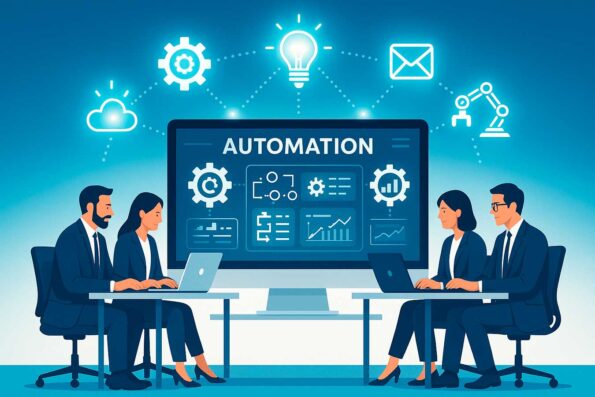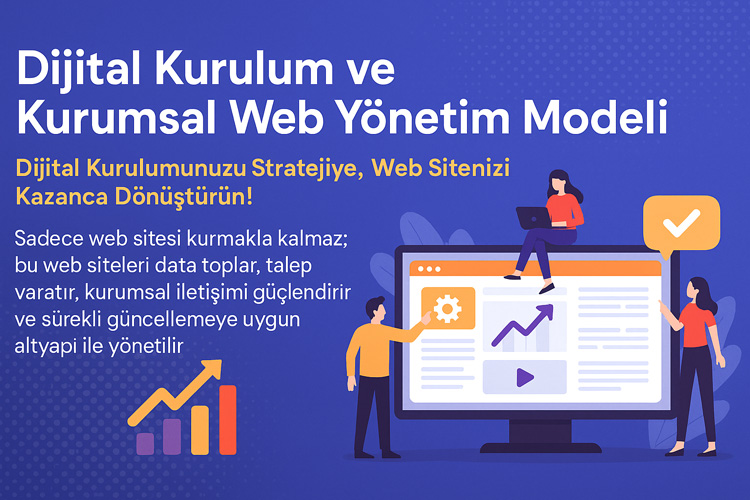Transitioning from Manual Processes to Automation: In the business world, productivity is achieved not only by working harder, but also by establishing the right systems and automating manual processes. Transitioning from Manual Processes to Automation is not only a time-saving change; it is also a strategic step that reduces error rates, lowers costs, and provides businesses with a competitive advantage. In traditional operations, human-based processes are both more time-consuming and have a high margin of error. However, automation makes each step defined, measurable, and sustainable. This guide will help you understand the process of “setting up the system” in your business step by step, learn which tools you should use, and discover the best place to start. 📈 Thanks to today’s technologies, whether you’re a small SME or an international company, you can quickly migrate your manual processes to digital and automation. The important thing here isn’t just investing in technology; The key is to plan the process correctly, train teams, and align the business culture with the transformation. In this article, we’ll examine in detail the steps involved, including analyzing manual processes, selecting automation tools, launching a pilot, and transitioning to full integration. Our goal isn’t just to provide theoretical information; It also helps you achieve a successful transformation with practical solutions you can implement immediately in your business.
İçindekiler
ToggleUnderstanding the Basic Logic of Automation
When deciding to Switch from Manual Processes to Automation in your business, it’s first necessary to clearly answer the question, “Why are we making this change?” Most businesses view automation solely as a technological upgrade, whereas it’s a strategic transformation that affects the entire structure of the business. If your goal is simply to reduce time, you could miss out on much of the potential. Automation also standardizes workflows, improves data quality, and allows you to set measurable performance targets.

Furthermore, every step taken during the transition process must be planned. Transitions without proper planning will not yield the expected efficiency; on the contrary, they can create chaos. Therefore, it’s essential to map processes, identify bottlenecks, and determine which steps are suitable for automation. This way, the transition process is completed both faster and at lower costs.
1. Map Your Manual Processes
The first step is to visualize your current manual processes in detail. Which steps are performed by whom, what data is used, and where do delays or errors occur? Providing clear answers to these questions will help you determine the right starting point for automation.
2. Identify Bottlenecks and Repetitive Tasks
In every business, certain processes create unnecessary repetition and waiting times. By identifying these points, you can identify the areas where automation will add the most value. This way, you can achieve faster results and increase team motivation.
3. Establish Criteria for Technology Selection
When choosing software or systems for automation, don’t focus solely on price or popularity. Your business’s scale, industry requirements, and future growth targets should be key factors in the selection process.
Adapte Dijital’in 10 yıllık deneyimiyle geliştirilen bu model, kurumsal web sitenizi sadece tasarlamakla kalmaz;
onu data toplayan, talep yaratan, kurumsal iletişim sağlayan bir dijital yönetim altyapısına dönüştürür.
Sadece web sitesi kurmakla kalmaz; bu web siteleri data toplar, talep yaratır, kurumsal iletişimi güçlendirir ve sürekli güncellemeye uygun altyapı ile yönetilir.
4. Start with a Small Pilot
Instead of replacing the entire system at once, start implementing automation in a specific process. This not only makes it easier for the team to adapt but also allows you to measure the return on investment more clearly.
Planning and Strategizing for the Transition to Automation
One of the most critical stages of the Transition from Manual Processes to Automation process is the planning and strategy development step. The goal here is not only to determine which tools to use.The goal is to clarify not only “what we will use,” but also “how we will deploy these tools.” An unplanned transition can lead to disruptions in the process, team resistance, and failure to deliver the expected return on investment. A strategic approach both positions the technology correctly and ensures the team can easily adapt to this change.
The planning process requires clarifying goals, defining budget limits, establishing a timeline, and organizing the team according to roles. The strategy should address not only current but also future business needs. In other words, automation shouldn’t just alleviate current workloads; it should be flexible enough to meet your future growth goals.
1. Clarify Your Goals
Clearly state why you want to automate. Is the goal simply to save time, or to improve data quality and standardize business processes? Clear goals guide both technology selection and implementation.
2. Plan Your Budget and Resources
Automation investments may seem costly initially. However, with proper planning, these costs are quickly recouped. Software licenses, training costs, and potential integration costs are included. Costs should be taken into account.
3. Create a Timeline
Create a timeline that includes the steps of the entire migration process. When will each phase begin, who will be responsible, and how long will it take to complete? A clear timeline keeps the process under control.
4. Define Roles Within the Team
Transitioning to automation is not solely the IT department’s job. It’s not. All departments, including operations, finance, sales, and customer service, need to be involved in the process. Knowing everyone’s role strengthens communication and collaboration.
Choosing the Right Automation Tools
The tools used in the Transition from Manual to Automated Processes process are a critical element that directly impacts success. Wrongly selected software may not meet the needs of the business and can also create additional costs and lost time. Therefore, both the technical requirements and the long-term goals of the business should be taken into account when selecting tools. A system chosen simply because it’s popular may not be compatible with your processes.
Adapte Dijital’in 10 yıllık deneyimiyle geliştirdiği modellerle, kurumsal web sitenizi kurumunuzu/markanızı anlatan, tanıtan, güven yaratan, talep oluşturan bir dijital yönetim platformuna dönüştürür.
Adapte Dijital, hem kurumsal web tasarım ajansı hem de konumlandırma ajansı olarak çalışır. Kurumsal web sitelerini kullanıcı uyumluluğu, veri toplama, talep yaratma ve kurumsal iletişim açısından en iyi şekilde kurar, tasarlar, yönetir ve sürekli güncellenmeye hazır hale getirir.
Choosing the right tools can significantly improve workflows. It speeds up the workflow, increases data accuracy, and improves the user experience. Furthermore, choosing solutions with high integration capabilities prevents compatibility issues when working with different software later. Evaluating industry-specific solutions at this stage can provide a competitive advantage.
1. Conduct a Needs Analysis
Before choosing an automation tool, determine what problems your business wants to solve. Clarifying your needs will allow you to use the right filters when choosing software.
2. Choose User-Friendly Interfaces
For team members to embrace technology, interfaces need to be easy to understand. Complex systems increase adoption time and reduce productivity.
3. Check Integration Capabilities
Investigate how compatible your chosen tool is with existing systems. API support and third-party integration capabilities provide long-term flexibility.
4. Choose Scalable Solutions
Consider that your business volume will increase in the future. The automation solution you choose willIt must be capable of handling the data load and the number of users.
Starting with a Pilot Application
When transitioning from manual processes to automation, the best approach is to start a small-scale pilot application rather than converting the entire system at once. This approach minimizes risks and simplifies the team’s adaptation to the new system. Thanks to the pilot implementation, potential errors in the process are identified early, and necessary optimizations are made.
The pilot phase is also an ideal opportunity to measure return on investment (ROI). It becomes clear which steps save more time, which processes reduce error rates, and how the team responds to the technology. This allows for addressing shortcomings before full-scale implementation.
1. Choose the Right Pilot Area
Start the automation experiment with a process whose impact can be easily measured. This will allow you to clearly see the results and increase team motivation.
2. Measure and Analyze Results
Define specific metrics to measure the pilot’s performance. Criteria such as time savings, error rates, and customer satisfaction should be prioritized.
3. Get Feedback from the Team
Feedback from the team that will use the system is as important as the technical data. User experience is a critical factor in the system’s success.
4. Make Necessary Corrections
Resolve issues and address any deficiencies that arise during the pilot phase. This way, you can move seamlessly into full implementation.
Transitioning to Scaled Automation and Integration
The most exciting, yet also most critical, phase of the Transition from Manual to Automation process is the full-scale implementation and integration phase. Based on the data gathered from the pilot implementation, deploying the system to all processes significantly increases efficiency across the business. However, the biggest risk at this stage is operational disruptions during the transition. Therefore, the implementation plan must be meticulously executed.
The full integration process doesn’t end with just the software deployment; full compatibility with existing systems, databases, and workflows must be ensured. Additionally, all teams must undergo adequate training to adapt to the new system. Thus, technology becomes a natural part of the business’s daily operations.

1. Prepare the Integration Plan
Create a detailed integration plan to ensure the smooth operation of all systems. This plan should cover data flow, authorizations, and security protocols.
2. Manage the Data Transfer Process Securely
To prevent data loss during the transfer of existing data to the new system, backups should be made and the transfer steps should proceed in a controlled manner.
3. Complete Team Training
For the successful implementation of the new system, teams must have sufficient technical and operational knowledge. Training should be completed before the system goes live.
4. Use a Gradual Transition Method
Instead of automating all processes at once, implement them gradually. This method allows you to detect potential errors early and fix them quickly.
Performance Monitoring and Continuous Improvement After Automation
Transitioning from Manual Process to Automation does not end with the system’s implementation; real success comes from regularly monitoring performance and implementing improvement steps. Automation is not a static structure; it is a system that must constantly evolve in line with business needs and technology. Therefore, performance measurement criteria should be established, regular reporting should be conducted, and inefficiencies in processes should be quickly addressed.
Continuous improvement ensures a business maintains its competitive edge. Because customer expectations, industry dynamics, and technological advancements are constantly changing, automation systems must keep pace. Otherwise, your system may become outdated and ineffective within a few years.
1. Identify Key Performance Indicators (KPIs)
Define clear KPIs to measure the success of automation. For example, metrics such as processing time, error rate, cost savings, and customer satisfaction should be prioritized.
2. Perform Regular Reporting and Analysis
Regularly analyze the data obtained from the system. This way, you can identify areas for improvement early.
3. Evaluate User Feedback
Feedback from team members and customers provides valuable insights for system improvement. Collect and implement this data regularly.
4. Keep Up with Technology Updates
New features in automation software can improve performance. Monitor updates regularly and implement those that meet your business needs.
Ensuring Team Adaptation to Automation Culture
In the transition from manual processes to automation process, another element as important as the technical infrastructure is the team’s adaptation to this new way of working. An automation culture doesn’t just mean using technology; it also transforms business processes, ways of thinking, and problem-solving methods. If the team resists this change, even the most advanced systems won’t deliver the expected efficiency.
The adaptation process is accelerated not only through training but also by employees directly seeing the benefits of this change. It should be clearly explained that automation simplifies work, reduces errors, and frees up time for more strategic tasks. This way, employees see technology as a supportive tool, not a threat.
Why is Digitalization Important? 5 Critical Reasons for SMBs
1. Establish Open Communication Channels
During the transition, create communication channels where employees can ask questions, raise concerns, and share suggestions.
2. Share Your Success Stories
Sharing examples demonstrating the positive effects of automation within the team accelerates adoption. This creates motivation in employees that “we can do it too.”
3. Make Training Continuous
Instead of one-time training, organize regular refresher sessions and new feature introductions.
4. Encourage Participation and Suggestions
Active employee participation in the process is critical to the success of the Manual Process to Automation Transition process. Ensuring participation facilitates faster system adoption and increased efficiency. Taking employee suggestions into account during the Manual Process to Automation Transition not only increases their motivation but also makes the processes more user-friendly. Furthermore, sharing experiences gained through the Manual Process to Automation Transition provides guidance for other teams. This approach encourages innovative thinking within the business culture and contributes to the sustainable success of automation.
Conducting Cost and Return on Investment (ROI) Analysis
One of the clearest indicators of success in the transition from manual processes to automation is the ability to clearly calculate the return on investment. ROI (Return on Investment) encompasses not only financial profit but also time savings, workforce efficiency, and customer satisfaction. In other words, the true value of automation should be measured not just by revenue growth, but by its contribution to the overall performance of the business.
This analysis also provides guidance for future automation investments. The data obtained will clarify which areas yield faster returns and which processes need further improvement. This way, you can optimize costs and make strategic investment decisions.
Digital Transformation vs. Digital Installation: Which One is Right for You?
1. Calculate Direct and Indirect Benefits
Direct benefits (cost reduction, time savings) and indirect benefits (customer satisfaction, employee productivity) provided by automation should be evaluated separately.
2. Compare Before and After Data
Measure the net impact by comparing process performance data before and after automation. This comparison makes the value of the investment tangible.
3. Evaluate Long-Term Impacts
Some automation investments yield long-term returns, not short-term ones. Therefore, evaluating with a 1-3-year perspective is more accurate.
4. Identify Improvement Areas
After the Transition from Manual Processes to Automation, it’s necessary to regularly identify areas for improvement to increase system efficiency. This step ensures that automation adds value to the business not only initially but also in the long term. Transition from Manual Processes to Automation allows you to more clearly identify bottlenecks, unnecessary steps, and performance losses in processes. Based on these identifications, the tools and workflows used in the Transition from Manual Processes to Automation process can be continuously optimized. This provides both cost advantages and allows the business to adapt quickly to changing market conditions.
Integrating Data Security and Compliance Processes
One of the most critical issues to consider in the Transition from Manual Processes to Automation phase is data security and legal compliance. Automation systems,It processes large amounts of data quickly and effectively, but it’s essential that this data be protected and managed in accordance with relevant regulations. Lack of data security can put businesses at risk of both financial losses and reputational damage.
Compliance processes are not only a legal obligation but also one of the most effective ways to instill customer trust. Data protection laws such as KVKK and GDPR, as well as industry standards, should be considered from the very beginning of the automation process. This ensures the system operates both efficiently and securely.
1. Create a Data Protection Policy
Data management is one of the most fundamental security steps in the Transition from Manual to Automated Process process. Creating a comprehensive policy on how all data will be collected, processed, and stored is critical to preventing potential data breaches. Transitioning from Manual to Automated Processes should ensure that data is regularly backed up, encrypted, and accessible only by authorized individuals. Furthermore, employees must be aware of and implement these policies during the Transitioning from Manual to Automated Processes process. This will both maintain legal compliance and increase customer trust. A strong data protection policy is key to long-term success.
2. Comply with Legal Regulations
Create processes to fully comply with KVKK, GDPR, or industry-specific regulations. This avoids potential fines and legal risks.
3. Strengthen Security Protocols
Data security is one of the most critical elements of the Manual Process to Automation Transition process. With automation, data is processed faster, but this also means security vulnerabilities can have more serious consequences. The Manual Process to Automation Transition should be supported by strong encryption methods, multi-factor authentication, and access authorization systems. This minimizes the risk of cyberattacks. Furthermore, regular security testing during the Manual Process to Automation Transition process ensures early detection of potential vulnerabilities. This ensures both legal compliance and strengthens customer trust.
4. Conduct Regular Audits
Identify and close security vulnerabilities by periodically auditing your automation system and data management processes.
Preparing for 2025 with the Digital Installation Model: Integration, Automation, and More
Preparing for the Future: New Trends and Opportunities in Automation
Transitioning from Manual Processes to Automation is a step that shapes not only the present but also the future. The rapid pace of technological change in the business world requires businesses to constantly pursue new opportunities. Trends such as artificial intelligence, machine learning, robotic process automation (RPA), and cloud-based solutions will determine the competitiveness of businesses in the coming years. Therefore, when establishing your automation system, you should ensure that it is flexible enough to adapt to future developments.
Preparing for the future is not limited to just keeping up with technology; it also includes acquiring new skills for the workforce, anticipating customer expectations, and redesigning business processes accordingly. This way, your business adapts not only to the current competitive landscape but also to the dynamics of the future.

1. Follow AI-Powered Automation
AI-based automation solutions make data analysis and decision-making processes more intelligent. Transition from Manual Process to Automation maximizes the operational efficiency of businesses through AI integration. This technology analyzes historical data, predicts future trends, and proactively optimizes processes. Transition from Manual Process to Automation, combined with artificial intelligence, not only saves time but also provides strategic decision support. Furthermore, using AI in the Transition from Manual Process to Automation process allows for faster and more accurate responses to customer needs. This puts you one step ahead of the competition.
2. Research Industry-Specific Automation Solutions
Each industry has different needs, and therefore automation solutions should be adapted to its dynamics. Transition from Manual Process to Automation ensures maximum efficiency thanks to industry-specific software. For example, in the manufacturing sector, quality control and inventory management, service In the industry, customer appointment and communication processes become more effective with automation. Transition from Manual Processes to Automation gives you a competitive advantage compared to standard solutions. Furthermore, customized systems compatible with Transition from Manual Processes to Automation enable your business processes to proceed faster and more accurately. This accelerates the return on your investment.
3. Develop Workforce Competencies
In the future, employees with the skills to work alongside automation will be a business’s most valuable asset. Transition from Manual Processes to Automation enables your team to become more strategic, data-driven, and technology-efficient. This Therefore, developing problem-solving and analytical thinking skills is as important as technical training. Transitioning from Manual Processes to Automation allows employees to free themselves from routine tasks and focus on innovative projects. Furthermore, the new competencies gained through Transitioning from Manual Processes to Automation will help your business maintain its competitive advantage in the long term. Making this investment is a critical step for future success.
4. Center on Customer Experience
In the future, automation will be used not only to speed up processes but also to personalize and enhance the customer experience. Transitioning from Manual Processes to Automation will enable you to meet customer requests faster, resolve complaints, This transformation allows you to minimize costs and increase satisfaction. This transformation allows you to establish customer-specific offers, personalized communication, and instant feedback mechanisms. Transition from Manual Process to Automation strengthens not only internal processes but also external relationships. Furthermore, thanks to Transition from Manual Process to Automation, you can make data-driven decisions, anticipate customer needs, and increase loyalty. This approach will be one of the strongest advantages that distinguishes your brand from competitors.
Excel or ERP? How to Make the Right Choice in Process Digitization?
Conclusion: Take the Right Step for Transformation Now
Transitioning from Manual Processes to Automation is not just a technology investment; it’s a strategic step that secures the future of your business. This process goes beyond saving time; it reduces error rates, increases efficiency, improves data quality, and permanently strengthens your competitive edge. With proper planning, appropriate tool selection, effective piloting, and robust integration steps, it’s possible to achieve this transition smoothly.
Remember that automation is not a static structure; it’s a dynamic system that constantly evolves and adapts to changes in the business world. Therefore, even after your transition is complete, performance monitoring, team compliance, andYou should continue taking steps like data security and trend monitoring. This way, you can position your business among the winners not only today but also in the future.
📌 Act Now!
Take the first step today to increase efficiency in your business processes, reduce costs, and boost your competitiveness. Transform your business with proper planning and a strong strategy on your Transition from Manual Processes to Automation journey.
💬 Contact us, and let’s determine the most suitable automation solutions for you. Digital Consulting Agency Adapte Dijital
📌 About This Content
This content has been prepared to help businesses take successful steps in the Transition from Manual Processes to Automation process. This guide covers all stages in detail, from analyzing manual workflows to selecting the right automation tools, from pilot applications to full integration. The purpose of this article is to offer a roadmap applicable to both SMEs and large-scale companies.
For professional solutions in corporate promotion, digital transformation, and content creation, you can find information at Kurumsal Tanıtım. Furthermore, as Adapte Dijital , we develop strategic solutions that accelerate the digital transformation of businesses with our experience in various sectors.







